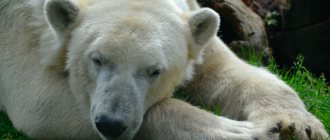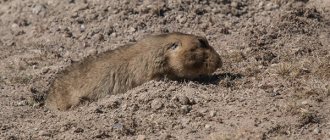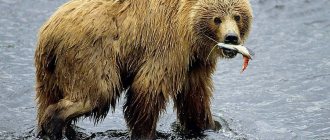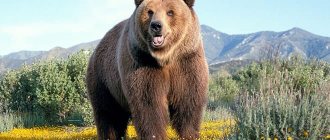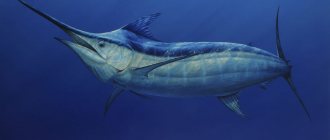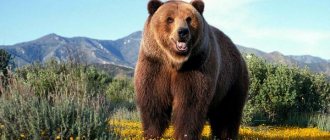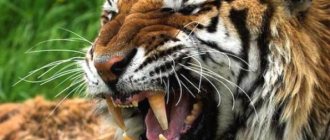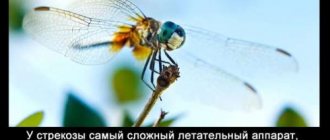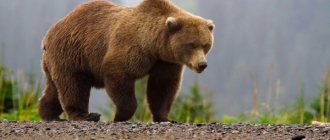There are many forests in the world, and they are home to a huge number of different animals. One of them is a bear - a very strong, cunning and, despite its apparent clumsiness, a fast and agile animal. Rarely will a person come out of a confrontation with him alive and well, and therefore meeting this animal one-on-one is strongly not recommended.
Although there are small and not very dangerous individuals in the bear family, they are also capable of causing significant damage to others. And it’s best to admire the largest bears in the world in zoos and national nature reserves. This article contains information about hero bears and their position in the ranking of “the most special”.
Gubach (weight 54 – 140 kg)
The bear has an original appearance and has a suitable nickname - sponger. It is otherwise called “sloth bear” for its resemblance to this sedentary animal. It is similar to a sloth in the structure and shape of the head, snout and eyes. The bear's lips are bare, extended into a proboscis. This is the reason for its name. Gubach closes the top ten largest bears in the world.
Its length is 1 m 80 cm, the weight of the smallest individuals is 54 kg, the largest - 140 kg. It has sickle-shaped claws, with the help of which it easily climbs trees and destroys termite mounds and anthills. After all, the sloth fish loves these colonial insects as food. But in general he is an omnivore - he loves honey, fruits, and will not refuse carrion.
The sloth fish lives in the forests of the Indian Peninsula (India, Nepal, Pakistan). Able to live up to forty years. But now it is endangered and is listed in the International Red Book.
Why bears lost fear and began to come out to people
But what motivates bears to enter cities and towns? Why did clubfoot people begin to lose their natural fear of humans? We talked about this with Doctor of Biological Sciences, Professor at the Institute of Ecology and Evolution. A.N. Severtsov RAS Leonid Baskin, who has been studying the character of these animals for more than 40 years.
Leonid Mironovich, in Sakhalin, Chukotka, and Yamal even developed instructions for residents on how to behave when meeting a clubfoot, so much so has it become an everyday occurrence. But what’s wrong with the bears: they no longer have enough food? Have the usual conditions changed in the forest?
Leonid Baskin: One of the reasons is garbage containers and landfills with food waste located on the outskirts of cities and towns. There are a lot of pictures of bears rummaging through tanks, fishing for an easy meal. It is a very fearless and highly adaptive beast. There are cases when people themselves hand-feed bears. What you absolutely cannot do. This is still a wild ferocious animal, and not a trained circus bear.
But, of course, it is not only the opportunity to eat for free that makes the owner of the taiga visit people. After all, bears used to come out to villages only in hungry years. This means that not everything is so simple; free complementary feeding is not the only answer to the question. The point here is also that recently bears have been hunted less. For various reasons: there is no longer a need to kill animals for food, and their skins are not particularly valued. And in general, we stand for the preservation of all living things that surround us. But reasonable hunting also serves as a regulator of the number of bears, as well as other large predators. They began to hunt less - as a result, the so-called planning of the number of clubfooted animals has practically disappeared. In the taiga in the northern regions there are significantly more of them than 10-15 years ago. In addition, the bear ceases to be afraid of a person with a gun, loses its natural fear.
Is it bad when there are a lot of bears in the forest? Who are they bothering in the taiga?
Leonid Baskin: First of all, to those who are hunted by these predators. On ungulates, elk, roe deer, deer, especially very small ones. The bear is a great specialist in young animals. In Chukotka, I had the opportunity to observe how a bear killed a dozen deer calves at once. He pulled them together into one pile, and very contentedly lay down on his booty. The ratio of the number of large predators to ungulates should be one to 30; this is considered the optimal balance in nature. In the northern regions it is today very disturbed. Sometimes this ratio is only one predator to five ungulates. For this reason, the moose population in our country is considered quite old. After all, a powerful, healthy elk is able to cope with the owner of the taiga, but a young one often cannot.
Ideally, for reasonable planning, 10-15 percent of the total bear population should be harvested annually. That is, if today, say, there are 800 bears in Yamal, it is necessary to kill 100-120. But in reality, only 8-10 are mined.
Rosprirodnadzor recently warned that it is better not to go to the forest in July, because bears are now in mating season, and they can be especially aggressive. Is this really true?
Leonid Baskin: It’s true that bears are now heading out onto the “marriage path.” Scientists have nicknamed the “weddings” of clubfooted animals because they slowly walk one after another across the clearing for some time before the mating process occurs. But I can’t say that right now they are showing aggression. In principle, it is very dangerous to encounter a bear. Especially when the mother bear is wandering around with her cubs. There is practically no chance of salvation then.
Does a bear attack only when it senses danger or can it purposefully hunt a person?
Leonid Baskin: He is a predator, and very smart and dangerous. In North America, bears often attack tourists in tents while they are sleeping. For us - for mushroom pickers and berry pickers. Every third case when this beast picks up a person is precisely for the purpose of eating him.
By the way, world statistics are kept on bear attacks on people: from 1991 to 2022, 290 attacks were recorded. Of course, the bear behaves very differently in different regions of our country and the world. In the European part of Russia, of course, you won’t see clubfooted animals near cities, but in Siberia you can. Over the 40 years of my personal observations, I saw a bear in the forests of the Kostroma region only four times. There they retained their natural fear, but in Kamchatka, for example, they saw several dozen animals at the same time when they went fishing.
This region is unique because salmon fish come there in huge numbers to spawn. Hence the extremely high number of bears, and the opportunity to see dozens of bears every day. For example, on Kuril Lake. Hence a lot of conflicts with people. By the way, Kamchatka bears reach gigantic sizes.
Is it true that these animals have cases of cannibalism?
Leonid Baskin: Yes, and they are not uncommon. Males may eat their own young when they are very hungry. The females know this very well, and they are wary of the “fathers” and try to protect the cubs from them.
Are there cases of polar and brown bears mating in the wild?
Leonid Baskin: Not much, but there are some. In particular, isolated examples have been noted in Alaska. In general, there are not many places on the planet where the habitats of these animals overlap. In our country, this is Taimyr, but so far there has been no data on “weddings” of brown and white people from there.
And then, they are very different in their “mentality”, although they have the same, but very distant ancestors. Their mating games take place differently, brown and white have their own special habits, and how they finally got together is actually very surprising.
Once an aboriginal hunter in Ugra told a popular belief in these parts: a bear whose cub was killed will then search for the offender all her life. He gave an example when a bear came to the shift workers’ trailer a year later to take revenge. Could this happen? Is it true that bears have such good memories?
Leonid Baskin: Their memory is really good, but in order to confirm this existing folk legend from a scientific point of view, an evidence base is still needed. That is, several similar confirmed cases, and only then will it be possible to analyze and draw conclusions.
But what should you do if you meet a bear on a narrow forest path?
Leonid Baskin: Firstly, to avoid encounters while walking through the forest, it is better to sing. And preferably louder. The bear is afraid of loud sounds. And he himself will most likely try to stay away from you.
But if you meet him, under no circumstances should you run away from him, the clubfoot moves very quickly and will overtake you instantly like prey. It is useless to climb a tree. He climbs trees much better than us. You need to calmly talk to the bear, looking him straight in the eyes: they say, bear, what are you doing, it’s time for you to go home, bear. And gradually back away, slowly moving away from him.
If he did not immediately attack you, it means that he did not have such a goal, and there is a chance that in this way you will gradually leave him. Sometimes they put a hat on a tall stick to make them look taller and more powerful in the eyes of the bear. Some hunters try to take advantage of the fact that the bear is blind. But I don’t think all these tricks work very well. It is not for nothing that among large predators the bear is considered the most intelligent, calculating and fearless animal.
Himalayan bear (weight 120 – 140 kg)
The Himalayan bear is also called the white-breasted or moon bear. It received this name because of its color. He himself is black, and on his chest there is a white spot in the shape of a crescent. This mammal ranks 9th in the ranking of the largest bears in the world.
Weighs about 140 kg, its height is 1 m 70 cm. Its food is mainly herbaceous plants, shoots of bushes, berries, acorns, and nuts. This food makes up the vast majority of his diet (about 90%). But if a frog, an anthill, or a dead animal comes across his way, he will not pass by. Quite aggressive, not afraid of humans.
Habitat: forests in the Himalayan mountains, Pakistani and Iranian forests, Korea and Japan. The Himalayan bear is found in the Far East of Russia (southern Khabarovsk Territory and Primorye). Representative of an endangered species in the Red Book.
Baribal - black bear
Baribal
Baribals are more widespread. This is also an American bear, whose domains start from Alaska and extend to Canada and the USA. Most often, they spend their lives in the forest, only occasionally going out into open areas - and then only in search of food. Bears live solitary lives, but during the period of childbirth, females can create groups to care for cubs - this is similar to a kind of kindergarten. Baribals choose mainly vegetarian food, which does not prevent them from periodically feasting on fish and meat. The growth of the forest giant reaches 2 meters (an adult, on its hind legs), weight is 330-360 kg .
Spectacled bear (weight 70 – 140 kg)
A unique specimen among the family of the largest bears in the world is the spectacled bear. Its habitat is South America. The beast prefers the forested mountainous terrain of the Andes. This is the only species in South America. Weight varies from 70 kg to 140 kg, length can reach 1 m 80 cm. It has a short muzzle compared to other bears. The eyes are surrounded by white and yellow circles, reminiscent of glasses.
He, like other big bears, builds a den for himself, but does not hibernate. It goes hunting at night or at dusk. It eats various roots, grass, shoots, and fruits. Sometimes kills deer, considered a loner. The lifespan is short - within 20 years. Listed in the Red Book as an endangered species.
Features of character and lifestyle
Photo: Short-faced bear
Most children, and even adults, imagine the image of a bear from a fairy tale as a kind, sweet and friendly animal. But in reality they are completely different. Therefore, at this point you can learn the character traits using the example of a giant short-faced bear.
In character and lifestyle, he differed from most predators. According to experts, most short-faced bears lived and hunted alone. They did not form into flocks. The character of the bulldog bear differed from other animals in its enormous endurance. For example, he could run for a long time without stopping over long distances at the speed of the wind.
They also had an imperious and leadership character, which probably meant that they could not be together in the same pack. The short-faced bear loved freedom and complete independence, so he preferred wide, spacious places, and did not like it when someone entered his territory. And if anyone dared to do this, then the animal would awaken into aggression and irritability, which could provoke him to kill.
Another pronounced character trait of the bulldog bear is stubbornness. For example, if he wanted to take prey from his opponent, he will fight to the last, but will get what he wants.
Giant panda (weight up to 160 kg)
One of the largest and kindest bears on Earth is the giant panda. The animal is painted in spots of black and white. The length of a giant panda can reach 1 m 80 cm, and the weight of the most massive specimen is 160 kg. His favorite food is bamboo leaves and stems. During the day, the animal can eat about 30 kg of them. If there is a shortage of bamboo, small animals, bird eggs, and insects are used.
This cute bear lives in the mountainous regions of China. Hunting for it is prohibited, and violating this prohibition is punishable by death. As a result of these activities, the giant panda ceased to be an “endangered species” and moved to the status of “vulnerable.”
Kermode (weight up to 300 kg)
The Kermode bear is named after the scientist Francis Kermode, who was the first to describe this animal. The Kermode bear is white or cream in color. But he is not a relative of the northern polar bear, but, on the contrary, a subspecies of the American black bear - baribal. Its body size is 1 m 80 cm, weight is about 300 kg.
The kermond lives in Canadian hard-to-reach forests. The Indians consider him a “ghost bear”; he is cautious and timid, and does not attack people. The mysterious animal loves to hunt salmon during spawning; collects mushrooms, berries, roots, fruits; will not refuse honey and carrion.
Interesting Facts
- Clubfoot are the heroes of many legends and tales, and many interesting facts have been collected about them:
- bears appear on many coats of arms of countries, provinces and cities (Greenland, Ontario, Berlin, Veliky Novgorod, Perm);
- Kodiak named Bart (1977-2000) - one of the most famous Hollywood animal actors, with a height of 2.9 m, weighed more than 700 kg;
- the Kodiak who lived in the Berlin Zoo in 1937 weighed about 1200 kg;
- The Kodiak's sense of smell is 4 times higher than that of a dog;
- the grizzly bear is the main figure on the California flag;
- in 2009, a man-eating grizzly weighing about 730 kg and more than 4 m long was killed in Alaska;
- the largest grizzly bear living in Yellowstone National Park weighed 408 kg, and in Katmai - more than 450 kg;
- since 2008, a 25-cent coin with the image of a grizzly fisherman has been put into circulation in the United States;
- the most famous polar bear born in captivity, Knut (2006-2011);
- Nanuk is capable of staying in water for up to 9 days, during which time it covers a distance of several hundred miles;
- in the Pleistocene era (about 100 thousand years ago), a subspecies of the giant polar bear lived, up to 4 m in length and weighing 1.2 tons; February 27 is International Polar Bear Day;
- oshkuy appears on Canadian and Austrian coins;
- One of the symbols of the Sochi Olympic Games was the polar bear cub.
Baribal (weight 330 – 360 kg)
Kermond's relative, the baribal, is in the middle of the ranking of the largest bears in the world. This two-meter-tall animal with black sparkling fur lives in the wooded areas of Canada, the United States of America, and Mexico. The food for this bear is fish, larvae, insects, acorns, and fruits. Sometimes attacks livestock.
The weight of the largest male is 363 kg. Its lifespan ranges from ten years in freedom to thirty in captivity. Now there are about 600 thousand baribals.
Grizzly bear (weight up to 450 kg)
The grizzly bear is a ferocious and ruthless predator. Outwardly, it is very similar to a brown bear (they belong to the same subspecies). But the grizzly is a more powerful and powerful mammal. Its weight is 450 kg, height is about 2 m 50 cm. Habitat: Alaska, Canada, USA. Main food: salmon, rodents, fruits, honey. Capable of killing an elk if desired. But it attacks a person only in a state of severe hunger or irritation. By the way, the grizzly bear ranks 7th in the ranking of the most dangerous animals in the world.
Description of appearance and habitat
Both types of bears are characterized by a developed musculoskeletal system and thick, durable skin.
The difference is as follows:
- Kodiak bears are distinguished by dense brown fur, which protects the animal from frost, which does not prevent Kodiak bears from lying down in a den for winter hibernation;
- the polar bear is characterized by smaller ears, an elongated neck and a flattened skull in comparison with the brown bear, as well as white coat color;
- Polar bears only hibernate for a month every couple of years. But females are able to rest for two to three months during pregnancy.
The bears' body is so adapted to a varied diet that they are not pure predators, but belong to the category of omnivores. But only Kodiaks living in relatively warmer latitudes are able to enjoy access to a variety of food, while their northern counterparts are content with meat and seafood.
Polar bear
The white polar bear appeared on the planet more than a hundred thousand years ago, descending from the brown bear. The spread of the population and adaptation to the environment led to the formation of a northern subspecies, adapted to constant frosts and survival in snowy areas at temperatures down to -60 degrees.
The largest individuals of polar bears now live in the Bering Sea region, in the coastal areas of the Arctic Ocean, and the total number fluctuates between twenty and thirty thousand.
Average physical characteristics of a polar bear:
- the weight of a polar bear reaches 500 kg for a male, 300 kg for a female;
- height at withers – 1.5 m;
- Body length in males is from two to two and a half meters, in females - one and a half to two meters.
The basis of the polar bear's survival is hunting. The animal hides behind an obstacle and inflicts a fatal blow on the victim with its paw. It attacks both walruses or seals, and other inhabitants in the near-water area. Able to take up space near thawed patches and ponds, catching fish.
The skin of a northern bear has a paradoxical structure: white fur serves to camouflage itself among the snow, and enhanced skin pigmentation protects the animal from solar radiation. After all, under the light hairs hides the same absolutely black skin that covers the animal’s nose. Under the skin there is a fatty layer ten centimeters thick, which protects the body from hypothermia in the northern cold.
Kodiak
This species also originated from brown bears and was named after Kodiak Island off the coast of Alaska, where it was discovered by researchers. But the subspecies also inhabits other island territories on the Kodiak archipelago, the total population is up to three thousand males and females.
Kodiaks are distinguished by well-developed muscles with long legs, a wide body and an enlarged skull.
Average physical indicators of a Kodiak:
- the weight of the male is four hundred and fifty kilograms, the female is two hundred and fifty kilograms;
- height at withers – one and a half meters;
- Body length in males is up to 2.8 meters, in females - between one and two meters.
The Kodiak brown bear prefers solitary living. Active survival is more diverse compared to polar bears - Kodiaks not only hunt and catch fish near bodies of water, but also eat berries and plant foods, and are able to eat carrion. The best conditions for Kodiaks involve a varied diet and the absence of a long winter.
Siberian brown bear (weight 750 – 800 kg)
Among the big brown relatives, the Siberian brown bear is the second largest. The body weight of the largest individuals reaches 800 kg, height – 2 m 50 cm. The animal is covered with dark brown fur. Lives in the dense forests of Eastern Siberia, Kazakhstan, Mongolia, and China. The diet of this mammal is 50% plant food, 50% food of animal origin. He is an avid fisherman and prefers shallow waters for fishing. The Siberian bear prefers solitude and spends the winter in a den, where females give birth to cubs.
Brown grizzly
Brown grizzly
Grizzly is the largest of the American bears; you can meet him in Alaska and in a number of American states. Such a meeting will not please you, because some individuals reach 450 kg or more in weight, with a height of up to 2.3 meters (an adult, on its hind legs)! Grizzlies are similar to European brown bears, differing only in habits and behavior. This is a dangerous bear for humans; stories about tragic encounters with it appear every year. By nature, the animal is omnivorous; its diet consists of plant and animal foods approximately 50/50.
Kodiak (weight 800 – 1000 kg)
The largest brown bear in the world, the Kodiak, is in an honorable second place in the ranking. The weight of the animal reaches one ton, the size of the body is 2 m 80 cm. Its body is knitted, sinewy, with a large head. The coat color ranges from dark brown to black. Habitat: Alaska (Kodiak archipelago). The Kodiak is omnivorous - it digs up roots, collects berries and herbs, catches salmon during spawning, and does not disdain carrion. Prefers a solitary lifestyle. The mammal is under state protection; only 160 animals are allowed to be shot per year. Today their number does not exceed 3 thousand.
Kodiak is a clever fisherman
Brown bears are considered one of the largest predatory mammals living on land, second only to polar bears in size.
Today there are 11 subspecies of the Brown bear, which differ in the size and color of their fur. The largest is Kodiak, common on the island of the same name and some nearby islands.
The animals are distinguished by their powerful physique, an adult male can grow up to 2.8 m in length, his height at the withers will be about 1.6 m, and his weight is 780 kg; females are usually smaller than males. The animals have long and strong legs, a massive body, a short tail and a large head with small ears. Such impressive sizes are explained by the fact that this subspecies lives on islands, where winter is relatively short and there is almost always a lot of food.
Kodiak was the most famous bear actor, starring in the films "The Bear" (1988) and "On the Edge" (1997)
Kodiaks are omnivores, and their diet is quite varied. They happily eat wild berries, roots, fresh herbaceous plants, and also hunt various animals. In addition, they are excellent fishermen, easily catching salmon jumping out of the water during seasonal migrations.
The number of Kodiaks is small, since many animals were destroyed due to active, uncontrolled hunting for them. Currently, there are only about 3 thousand of these powerful animals in nature, and they are under state protection.
Polar bear (weight up to 1 ton)
The winner of the ranking of the largest bears in the world is the white (polar) bear. The length of the giant can reach three meters, and its mass can reach one ton. The territory of settlement of the predatory animal is located in the coastal part of the Arctic Ocean. Compared to other bears, its neck is more elongated, its head is flattened, its hair is thick and long.
The mammal is an excellent swimmer and diver and is agile on land. It feeds on representatives of the sea fauna: seals, sea hares, walruses. Bird eggs and their young are also used. The bear will not pass by the corpses of animals and fish; on occasion, it will rummage through garbage dumps and plunder the food warehouse of polar explorers.
White giants live for up to 30 years. There are twenty-eight thousand of these mammals on the planet, of which six thousand are in Russia. Despite prohibited hunting measures, about two hundred of these beautiful animals die annually on Russian territory.
Animals Nature
Prehistoric bears
Comparison of the short-faced bear and humans
According to paleontologists, bears appeared approximately 7 million years ago, and after 2 million they settled over a large area, forming several species. The largest of them turned out to be a short-faced bear. An extinct giant with a height of up to 2-3 meters at the withers , weighing up to 1400 kg or more. These huge predators lived during the Ice Age, when gigantism among mammals was very common. There were other ancient bears of large sizes, but they all became extinct, and therefore it is worth moving on to their large descendants.
